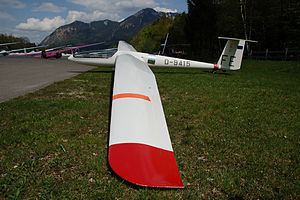Wingspan 18 m | ||
 | ||
The Glasflügel BS-1, sometimes called the Björn Stender BS-1 or the Stender BS-1, is a West German, high-wing, single seat, T-tailed, FAI Open Class glider that was designed by Björn Stender and produced by Glasflügel.
Contents
Design and development
The prototype BS-1 was designed by Stender as the initials indicate; the BS-1 was closely based on his earlier Akaflieg Braunschweig SB-6 Nixope, produced whilst he was still an undergraduate. Two prototypes were built by him and his three assistants in 1962. He was then a young engineering student and designed the aircraft at the request of a South African sailplane pilot and industrialist, producing a design that was very advanced for its time. While the designer was test flying of one of the prototypes in 1963 the aircraft suffered an in-flight structural failure and Stender was killed. Glasflügel then took over the project and re-engineered the design, based on their experience producing the Glasflügel H-301 Libelle. The company went on to build 18 production aircraft.
The BS-1 is constructed entirely from fiberglass and features an 18.0 m (59.1 ft) wing with flaps and dive brakes. For further glidepath control the BS-1 has a tail-mounted parachute. The landing gear is a retractable monowheel.
A planned improved model, the BS-1b, was never produced.
Operational history
The BS-1 was considered one of the first soaring "super ships" and was one of the most high-performing gliders of its time, the mid-1960s. Alfred Rohm of West Germany flew a BS-1 to a world 300 km (186 mi) speed record of 135.3 km/h (84 mph) in 1967. Thierry Thys of San Leandro, California flew a BS-1 on a 917 km (570 mi) flight in 1970. At that time it was the third-longest soaring flight ever made.
Aircraft on display
Specifications (BS-1)
Data from Sailplane Directory and Soaring
General characteristics
Performance
